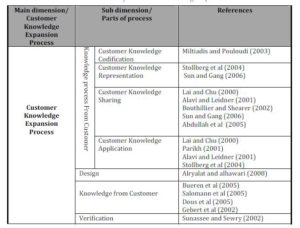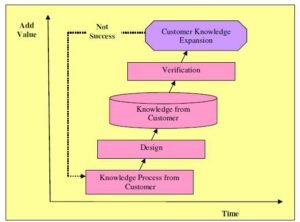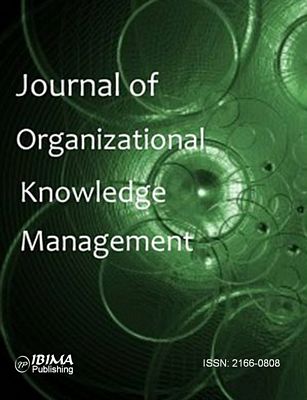Introduction
Due to the Knowledge Management (KM) revolution, Organizations have started to recognize the importance of knowing their customers better to provide information services due the rapid change in the business environment. Therefore, KM process is essential in modern and successful organizations which look at knowledge as major factor in competitiveness. KM can be seen as a fast response to weakness and threats that affect the way of organization business.
In addressing this issue, knowledge process from customer has become very necessary for building an efficient and successful relationship with customers and to achieve customer knowledge expansion.
The logic of business is shifting from mass-production to knowledge-intensiveness. This progression applies to both modern industries, such as information and communication technology, and more traditional ones, say the forest industry. The most important theoretical constructions to tackle this timely issue are the concepts of KM. Additionally, KM is the process of capturing or creating knowledge, storing it, updating it constantly, interpreting it and using it whenever necessary (Turban et al 2008).
As a key concept KM has surfaced as a major issue that managers must deal with if they want to maintain a competitive advantage and to achieve customer knowledge expansion in a long term. Additionally, knowledge about competitors, customers, products, processes and past successes and failures are considered as an asset for the organization in the twenty-first century (Lehaney et al 2004).
Despite the fact that customer knowledge expansion is a key concept to organizations if they want to maintain a competitive advantage and to achieve successful relationship with their customers, yet it is still very little in the literature to tell about this topic and about how knowledge from customers, has the exciting impact that was predicted by many organizations.
Our study is therefore unique in sense that it proposes a clear model that makes a more reliable, confident, and valid relation between knowledge processes from customer and customer expansion. The rest of the paper is structured as follow: Section two introduces review of related studies associated with customer knowledge flows. Section three presents a conceptual model for customer knowledge expansion process, and finally the conclusion is presented.
Literature Review
Due to the rapid growing of customers’ demands, and the intensive competition among organizations, expansion relationship with their customers has become a major concern that faces these organizations (Alryalat et al 2007).
In this regard knowledge has become a strategic resource of an organization and customer knowledge has been recognized as an important asset for sustaining a competitive advantage (Papoutsakis, and Vallès 2007) Consequently, many modern organizations start to utilize and manage their customer knowledge resources in favor of gaining competitive advantage as a prime significance for organizations’ performance to grow and compete with domestic and global competitors.
The objectives of KM are to make the organization act as intelligently as possible to be growth in term of viability and overall process, and to realize the best value of its knowledge assets. Moreover, knowledge currently is regarded as one of the vital resources of modern organization (Moczydlowska, 2007).
In fact, during the global economy, unstable changes and strong competitive market, knowledge played a major role in establishing the company’s position on the market, opportunities for development and capital growth as a result (Moczydlowska,2007). Additionally, as products and processes increase in their complexity, and the pressure to maintain and create competitive advantage through fast and constant innovation, current companies replying on efficient management of the knowledge developed through their research and activities (Parikh,2001).
Customer Knowledge Flows
Customer Knowledge has increasingly been recognized within marketing as a significant resource that can be managed to support research and development (Gebert et al 2002). Also, Bueren et al (2005) Note that organizations need to focus on three sorts of knowledge in Customer Relationship Management (CRM) processes.
Firstly, they need to understand the requirements of customers in order to address them. This is referred to as knowledge about customers. Secondly, the information needs of the customers in their interaction with the enterprise require knowledge for customers.
Thirdly, customers possess knowledge about the products and services they use as well as about how they perceive the offerings they purchased. This is referred to as knowledge from customers. This knowledge from customers is valuable as it feeds into measures to improve products and services. Efforts need to be made to channel this knowledge back into the organizations.
Additionally, Salomann et al (2005) distinguish between three kinds of knowledge flows that play a vital role in the interaction between an organization and its customers: knowledge for, from and about customers.
Knowledge for customers to support customers in their buying cycle, a continuous knowledge flow directed from the company to its customers. Knowledge from customers has to be incorporated by the company for product and service innovation as well as for the continuous improvement of its products and services. Knowledge about customers is collected in CRM service and support processes and analyzed in CRM analysis processes.
The model by Dous et al (2005) present knowledge flows in CRM processes can be classified into three categories: They need to understand the requirements of customers in order to address them. This is referred to as knowledge about customers. Customer needs must be matched with the services and products available. All knowledge required here fore can be summarized under the term knowledge for customers.
Finally customers gain many experiences and insights when utilizing a product or service. This knowledge is valuable as it can be used for service and product enhancements. This knowledge from customers must be channeled back into an enterprise.
Finally, Gebert et al (2002) explain knowledge flows in CRM processes can be classified into three categories: First knowledge about customers is accumulated to understand motivations of customers and to address them in a personalized way.
This includes customer histories, connections, requirements, expectations, and purchasing activity. Second Knowledge for customers is required in CRM processes to satisfy knowledge needs of customers. Third knowledge from customers is knowledge of customers about products, suppliers and markets. Within interactions with customers this knowledge can be gathered to feed continuous improvement.
Phases of Process from Knowledge
The authors propose the taxonomies for the process from knowledge; this taxonomy is based on a set of processes such as knowledge codification, knowledge representation, knowledge sharing, and knowledge application. To achieve the process from knowledge, four sub stages need to be taken into account as shown in Table 1 (Alryalat et al 2007).
Table 1: Taxonomy of Process from Knowledge

The first stage deals with knowledge codification. The codification process involves the conversion of a certain validated knowledge into an explicit form. It is used to represent knowledge in a transferable, comprehensible and easily accessible format (Alryalat et al 2007). The purpose of codification is to convert the knowledge into an easily accessible application format. Miltiadis and Pouloudi (2003) define the acquired process refers to the facility of the project team member to formalize, codify, represent, format and map the knowledge fundamentals in order to secure their existence in a usable format.
The second stage concerns with knowledge representation. It refers to the process of displaying or representing knowledge in a description of familiar terms. The direct aim of this process is to represent the knowledge captured in an explicit form that reflects a simple view. The knowledge representation is based on storing and manipulating the knowledge in IT applications such as expert system, information retrieval. Stollberg et al (2004) Describe that Knowledge Preparation stage is mainly focused on the presentation of information in an easy to learn way. Also, knowledge allocation process describes how to present of information in an easy accessible way Knowledge representation means to represent the knowledge in a more clear (Sun and Gang, 2006).
The third stage is concerned with sharing the codified knowledge with other individuals. This sharing of knowledge supports the transfer of the knowledge to others by improving individuals’ innovativeness and performance. Distributing and transfer phase is concerned with how to distribute knowledge to other people (Lai and Chu 2000).
In addition, knowledge transfer which is concerned more with communication channels available and make faster access to knowledge sources (Alavi and Leidner 2001). Additionally, knowledge sharing phase involves the transfer of knowledge from one person to another on or more (Bouthillier and Shearer 2002).
Also, The KM system can disseminate knowledge in a collaboration environment essentially into four ways, depending on whether the communication method is synchronous or asynchronous or combination of both (Abdullah et al 2005). Therefore, knowledge sharing is performed by distribution and utilization of the knowledge that has been selected or generated from the organization and acquired outside (Sun and Gang 2006).
The fourth stage focuses on applying knowledge to organizations’ products, services and processes which yields in attaining high standards of improvement and progress. This final stage helps individuals utilize the knowledge possessed by other individuals without necessarily attaining that knowledge. Lai and Chu (2000) Point out that use of the knowledge describes how to develop knowledge in order to produce commercial value.
Additionally, knowledge application can be considered as an activity to increases applying knowledge to a new scenario and learning from it (Parikh 2001). Also, knowledge application process is used to apply knowledge in many locations more rapid application of new knowledge through workflow automation (Alavi and Leidner 2001).
Knowledge usage it is a process ensuring that people use knowledge in KM system (Stollberg et al 2004). Furthermore, process of use means knowledge of how to use the KM system in a collaboration environment will be increased (Abdullah et al 2005).
Proposed Customer Knowledge Expansion Processes
KM can be useful for the success of CRM activity (customer acquisition, customer retention, and customer expansion). As a concept, KM process is one of the important factors for achievement of CRM in the long term. Study of the KM process is important for the organization to verify the objective and how achieve this objective.
The processes of customer expansion are of prime value for organizations. Many organizations fail because there is no clear strategy for dealing with customers, and specifically the process of customer expansion.
Therefore, customer expansion is of major importance as the major stage of the CRM process. Successful organizations depend on customer expansion as the only way that ensures their survival in the competitive advantage.
Customer knowledge expansion is the process of deepening and sustaining the relationship with the most valuable customers. It is concerned with developing a value proposition relationship management with the customer. This act of sustaining the relationship will automatically results in turning the customers into profitable ones.
The authors propose the taxonomies for the customer knowledge expansion Process; this taxonomy is based on Table 1 (Alryalat et al 2007) However, to achieve the customer knowledge expansion, we need to consider the four sub phases (Knowledge process From Customer, Design, Knowledge from Customer, and Verification) see Table 2.

The customer knowledge expansion model describes how process from knowledge helps expanding the relationship with customer. Organizations must take into their consideration maintaining a strong relationship with the customers to the extent in which the latter become profitable ones. There are forth phases in a customer knowledge expansion model based on Table 1 and Table 2, see Figure 1.
The first phase refers to knowledge process from customer. This phase consists of four sub stages. The first stage deals with customer knowledge codification. The codification stage involves the conversion of validated customer knowledge into explicit form.
It is used to represent customer knowledge in transferable, comprehensible and easily accessible format. Also, the second stage deals with customer knowledge representations. It describes the knowledge in familiar terms. The aim of this phase is to represent the customer knowledge in explicit form to make the view simple.
Additionally, the third stage is concerned with customer knowledge sharing. It refers to the transfer of the customer knowledge to others by boosting individual’s innovativeness and performance. Finally, the forth stage focus on applying customer knowledge to organization’s products, services and processes aiming in certain ways to improve them. This final stage helps individuals utilize the customer knowledge possessed by other individuals.
The second phase is called design which is defined as the systematic plan or a guide for extending the relationship with the customers (Alryalat and alhawari 2008). It is not only concerned with preserving the relationship with the customer.
But it also prepares the company for a profound and long-term relationship. It determines the important steps needed to achieve an insightful affiliation between the organization and their customers. This phase produces knowledge base called knowledge from customer (third phase) includes customer knowledge to improve products and services.
The fourth phase is concerned with verification. If customer expansion phases do not succeed, the organization needs to go back to knowledge process from customer stage.

Figure 1: Phases of Customer Knowledge Expansion Model
Based on the above figure, the author takes into consideration the time and value factors to carry out the steps of customer knowledge expansion. The relationship between these two factors is that when the time that is needed to carry out the steps of customer knowledge expansion increases, the value of customer knowledge expansion will become higher.
Conclusion
It has been observed that the main competitive advantage for an organization lies in the organization’s Knowledge and therefore KM has become a vital issue. In order to accelerate the progress of research in KM, this paper presents a conceptual framework of customer knowledge expansion, the objectives of the paper is to describe a more valid process to improve customer knowledge expansion.
Based on the topic of this research, this paper concluded that customer knowledge expansion model would give the broadest analysis of the customer expansion. Consequently, the paper describes the role process from knowledge to achievement customer knowledge expansion.
This processes help to deepening and sustaining the relationship with the most valuable customers. It is concerned with developing a value proposition relationship management with the customer. Therefore, this paper contributes to this field by providing a clear model for employing customer knowledge expansion process as a model to make reliable, confident, and valid process to keep organizations within competitive environment.
References
Alavi, M., and Leidner, D. (2001), ‘Review: Knowledge Management and Knowledge Management System: Conceptual Foundations and Research Issues,’ MIS Quarterly, 25(1), 107-136.
Abdullah, R., Selamat, M. H., Sahibudin, S., and Alias, R. A. (2005), ‘A Framework For Knowledge Management System Implementation In Collaborative Environment For Higher Learning Institution,’ Journal of Knowledge Management Practice, 6.
Alryalat, H and Alhawari S.(2008), ‘Towards Customer Knowledge Relationship Management: Integrating Knowledge Management and Customer Relationship Management process,’ Journal of Information and Knowledge Management (JIKM), 7(3), 145-157.
Alryalat H., Alhawari S., and AL-Omoush K. (2007), ‘An Integrated Model for Knowledge Management and Customer Relationship Management’ proceedings of 8th International Business Information Management Association Conference (IBIMA) ISBN: 0-9753393-7-0) Dublin, Ireland, June 20-22.
AlKhaldi F., Karadsheh L., and Alhawari S. (2006), ‘Knowledge Management Life Cycle: an Investigative Methodology toward a Conceptual Framework’ Proceedings of Sixth annual international Conference for Business Ethics and Knowledge Society, ALZaytoonah Private University of Jordan.
Bouthillier, F., and Shearer, K. (2002), ‘Understanding knowledge management and information management: the need for an empirical perspective’ Information Research Journal, 8(1), 1 39.
Bueren, A., Schierholz, R., Kolbe, L., and Brenner, W. (2005), ‘Improving performance of customer processes with knowledge management Business,’ Process Management Journal, 11(5), 573 -588.
Dous, M., Salomann, H., Kolbe, L., and Walter Brenner, W. (2005), ‘Knowledge Management Capabilities in CRM: Making Knowledge For, From and About Customers Work’ Proceedings of the Eleventh Americas Conference on Information Systems, pp. 167-178, Omaha, NE, USA.
Gebert, H., Geib, M., Kolbe, L. and Riempp, G. (2002), ‘Towards Customer Knowledge Management: Integrating Customer Relationship Management and Knowledge Management Concepts’ Proceedings of the 2nd International Conference on Electronic Business, Taipei, Taiwan.
Lai, H., and Chu, T. H. (2002), ‘Knowledge Management: A Review of Theoretical Frameworks and Industrial Cases’ Proceedings of the 33rd Hawaii International Conference on System Sciences, IEEE.
Lehaney B., Clarke S., Coakes E and Jack G. (2004), ‘Beyond Knowledge Management’ Idea Group Publishing, ISBN: 1591402239.
Miltiadis, D.L., and Pouloudi, A. (2003), ‘Project management as a knowledge management prime: the learning infrastructure in knowledge-intensive organizations: projects as knowledge transformations and beyond’ The Learning Organization Journal, 10(4), 237-250.
Moczydlowska, J. (2007), ‘Organizational Knowledge Measurement’ Proceedings of the Computer Information Systems and Industrial Management Applications, CISIM ’07.
Parikh M. (2001), ‘Knowledge Management Framework for High tech Research and Development’ Engineering Management Journal, 13(3), 27-34.
Papoutsakis, H., and Vallès, R. S. (2006), ‘Linking Knowledge Management and Information Technology to Business Performance: A Literature Review and a Proposed Model’ Journal of Knowledge Management Practice, 7(1).
Salomann, H., Dous, M., Kolbe, L., and Brenner, W. (2005), ‘Rejuvenating Customer Management: How to Make Knowledge For, From and About Customers Work’ European Management Journal, 23(4), 392-403.
Stollberg Michael., Anna V. Zhdanova., Dieter Fensel. (2004), ‘H-TechSight A Next Generation Knowledge Management Platform’ Journal of information and Knowledge management, 3(1), 47-66.
Sunassee, N., and Sewry, A.(2002 ‘)A Theoretical Framework for Knowledge Management Implementation’ Proceedings annual research conference of the South African institute of computer scientists and information technologists (SAICSIT) on Enablement through technology, pp. 235-245.
Sun, Z., and Gang Gao. (2006) ‘HSM: A Hierarchical Spiral Model for Knowledge Management’ Proceedings the 2nd International Conference on Information Management and Business, Sydney Australia.
Turban E., king D., Viehland D., and lee J. (2008) Electronic Commerce: A managerial Perspective, Prentice Hall.






